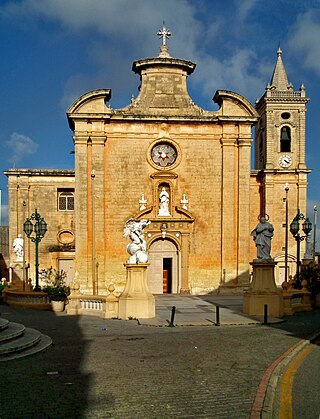
Balzan is a municipality in the Central Region of Malta, one of the so-called three villages, together with Attard and Lija. The village originally consisted of a group of small dwellings and farms but eventually grew, becoming a parish in the 17th century. As of 2021, the town registered a population of 4,774 inhabitants.

Victoria, also known among the native Maltese as Rabat or by its title Città Victoria, is an administrative unit of Malta, and the main town on Gozo. Victoria has a total population of 6,901, and by population, is the largest locality in Gozo.

Siġġiewi, also called by its title Città Ferdinand, is a city and a local council in the Southern Region of Malta. It is the third largest council in Malta by surface area, after Rabat and Mellieħa. Siġġiewi is situated on a plateau a few kilometers away from Mdina and 10 kilometres away from Valletta, the contemporary capital. It is the home of 8,721 inhabitants as of January 2019. Until several decades ago, almost all of the population was employed in the fields which surround the city. In 1993, the city adopted the motto Labore et Virtute.

Mosta is a small but densely populated city in the Northern Region of Malta. The most prominent building in Mosta is the Rotunda, a large basilica built by its parishioners' volunteer labour. It features the world's 3rd largest unsupported dome, and displays a replica of a German bombshell that famously crashed through the dome but did not detonate upon impact.

Tarxien is a town in the South Eastern Region of Malta. Its population stood at 8583 in March 2014.

Żurrieq is a town in the Southern Region of Malta. It is one of the oldest towns in the country, and it has a population of 11,823 inhabitants as of March 2014. Żurrieq is one of the 10 parishes to be documented in 1436 and it is dedicated to Saint Catherine. The island of Filfla is administratively a part of the town. The town stretches from Nigret to Ħal Far. In old times the town was had a border with Żejtun. The village of Qrendi used to be part of the parish of Żurrieq until 1618 when it was made into its own parish.

Żabbar, also known as Città Hompesch, is a city in the South Eastern Region of Malta. It is the seventh largest city in the country, with an estimated population of 15,648 as of January 2021. Originally a part of Żejtun, Żabbar was granted the title of Città Hompesch by the last of the Grand Masters of the Order of St. John to reign in Malta, Ferdinand von Hompesch zu Bolheim.

Safi is a village in the Southern Region of Malta, bordering Żurrieq and Kirkop. It has a population of 2,126 people as of March 2014.

Lija is a small village in the Central Region of Malta. It forms part of the Three villages of Malta, along with Attard and Balzan. Lija has a baroque parish church and seven other small chapels. The parish church is dedicated to Our Saviour. Lija became a parish in 1594, after the small community detached itself from the neighbouring town, Birkirkara. It has a population of 3,162 as of 2021.

Gudja is a village in the Southern Region of Malta, with a population of 3,148 as of March 2017. The village is located on high grounds, south of Valletta. It is administered by the Gudja Local Council. A number of schools, clubs, public gardens and recreations places are found around the village.

The Catherine wheel or pinwheel is a type of firework consisting either of a powder-filled spiral tube, or an angled rocket mounted with a pin through its center. When ignited, the energy of the fireworks not only create sparks and flame, but cause the wheel to quickly rotate, making the display much more spectacular. The physics of the process are those of an aeolipile.

Qrendi is a village in the Southern Region of Malta, with a population of 3148 people as of October 2021. It is located close to Mqabba, Żurrieq and Siggiewi. Within its boundaries are two well-known Neolithic temples called Mnajdra and Ħaġar Qim. In this village two feasts are held annually. The feast of Our Lady of Lourdes is celebrated either on the last Sunday of June or on the first Sunday of July, with 15 August the titular feast of the Ascension of Our Lady. This feast is popularly known as the feast of Santa Maria.

Għaxaq is a village in the Southern Region of Malta, with a population of 5,538 as of November 2021. The surrounding areas is predominantly used for agriculture.

Qala is an administrative unit of Malta, on the island of Gozo, with a population of 1,929 as of September 2019. Nearby is Ħondoq ir-Rummien, a coastline with salt pans and caves.
Malta is the country with the most holidays in the European Union. Since 2020, any holidays falling on Saturdays or Sundays add an extra day to the workers' leave pool, reverting to the pre 2005 system.
The St. Catherine Band Club, or Socjeta Muzikali Santa Katarina, is one of the two bands in Zurrieq, Malta. In 1864 the band was created from an orchestra known in Italian as La Filarmonica del Zurrico. In 1944 the bandmaster was Espedito Deguara, a well known musician in Malta.

In the small Mediterranean island nation of Malta, the predominant religion is Roman Catholicism.
Church of the Assumption or Church of the Assumption of Mary may refer to:

Mariano Gerada (1766–1823) was a Maltese sculptor.

The Church of the Assumption is a Roman Catholic parish church located in Qrendi, Malta.






















